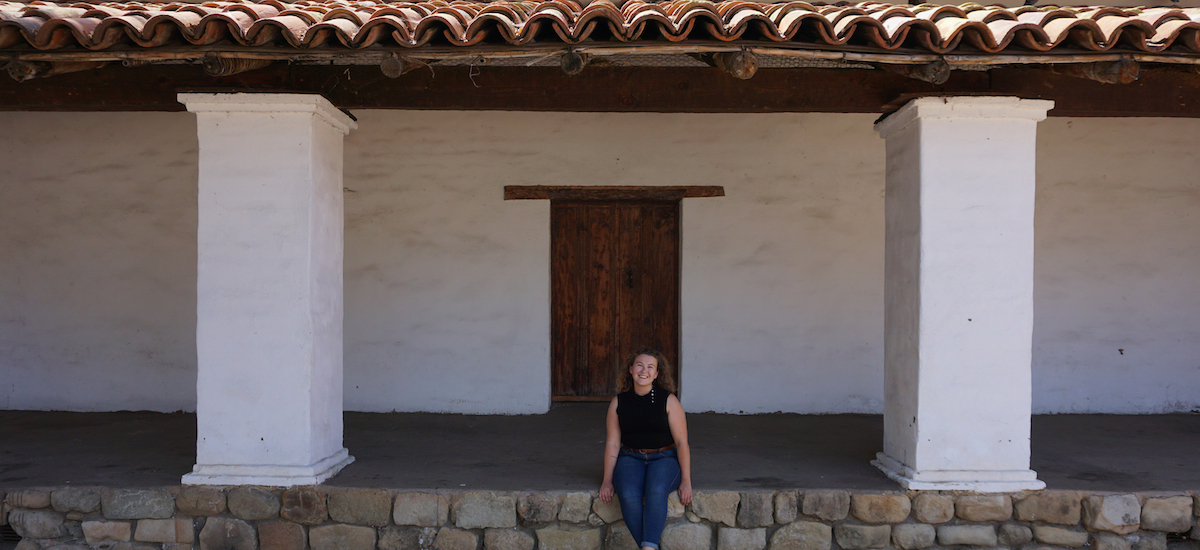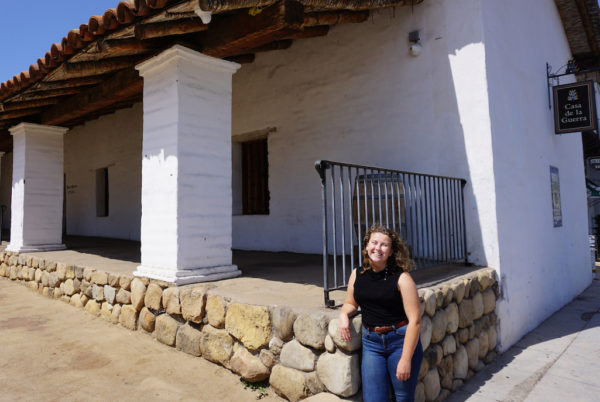
19 Aug IHC Public Humanities Graduate Fellow Intern Emma John
August 19, 2019
Emma John is a second-year PhD student in History at UC Santa Barbara interested in public history and nineteenth-century U.S. history with a particular focus on women. As an IHC Public Humanities Graduate Fellow, John is currently completing an internship at the Santa Barbara Trust for Historic Preservation, and has been working with the Casa de la Guerra, a historic house museum maintained by the Trust and former residence of José de la Guerra, the fifth comandante of the Presidio.
As a Public Humanities Graduate Fellow you are interning this summer at the Santa Barbara Trust for Historic Preservation (SBTHP). What work are you doing in the internship?
This summer I have tackled a few projects. I started the summer designing new programming activities for Casa de la Guerra. These programs are meant to foster new types of engagement with the space—either moving through it differently or, for school groups, connecting the de la Guerra story to what students are learning about in Social Studies classes. At the moment I am helping design a brochure for Casa de la Guerra. This has involved consultation with museum employees, research, and selecting appropriate images from the Presidio Research Center to best represent the museum and the de la Guerra family. When finished, the brochure will provide a brief but informative introduction to the site.
What has your investigation into the history of the De la Guerra family revealed about the historical and continuing significance of the Casa de la Guerra site for the Santa Barbara community?
Learning about the de la Guerra family has been key to answering the larger questions I had about the history of Santa Barbara. Coming from the East Coast, I knew very little about the history of California. Casa de la Guerra is not only significant to Santa Barbara’s history, but to California’s history. When they were first building Casa de la Guerra, Spain ruled Santa Barbara. By the home’s completion, Santa Barbara was part of Mexico. Jose died in 1858 as a citizen of the United States. Casa de la Guerra is representative of the significant cultural changes that have impacted Santa Barbara from the town’s inception.
Additionally, Casa de la Guerra has historically served as a town center. Jose de la Guerra was held in high esteem by Santa Barbara and his home often served as a site of social and civic functions such as weddings or settling legal disputes. Plaza de la Guerra was specifically built where it is and named in honor of the family in 1853. Given that Plaza de la Guerra is back in the news, it is interesting to consider the site’s historical roots and significance.
 Your research is helping to shape new interpretive programming at Casa de la Guerra. What might this programming look like?
Your research is helping to shape new interpretive programming at Casa de la Guerra. What might this programming look like?
Something great about the de la Guerra family is that several researchers have already documented their lives. I am utilizing that work to create programming that helps visitors imagine Casa de la Guerra as it existed in the nineteenth century—a bustling hub of activity. For students I am trying to create programming in line with California curriculum standards. This might mean imagining the de la Guerra family in the context of Westward expansion, or considering the civic issues of Plaza de la Guerra.
There are ongoing discussions about revitalizing De La Guerra Plaza, just opposite Casa de la Guerra. Is your work at SBTHP informing any of those discussions?
I have been considering ways of incorporating Plaza de la Guerra into museum programming. While it is important for museums to consider contemporary issues, it is also important to consider the longevity of programming versus current events. The goal is to incorporate contemporary issues such as talks of revitalizing Plaza de la Guerra while also making sure there are other programming ideas that will be relevant even after town discussions have shifted elsewhere.
Your research interests are in New England house museums; has this internship aligned with some of that work and/or pushed you in new directions?
Again, growing up in the Northeast has led to some, *ahem* strong regional biases. However, I have been overcoming those biases while learning about Santa Barbara’s history and the history of California in general. It has been great to get out of my historical comfort zone and imagine how my research interests make sense in California.
What has been the most exciting or rewarding part of the internship so far?
I love learning about local history wherever I am, and this internship has provided an unmatched opportunity to do just that. The trust does so much cool working interpreting and teaching Santa Barbara’s history and I’m thankful to be a small part of it.
How has your work so far in the Public Humanities Graduate Fellows program influenced your understanding of the role of public humanists in their local communities?
We had such a wide variety of guest speakers [in the Skills for the Public Sphere course] and internship opportunities this past spring—things that I had not even considered would fall under the umbrella of public humanities. So I certainly have a greater understanding of what is possible as a public humanist. Additionally, I’ve been learning about the importance of teamwork and collaboration. Historians are really good at solo pursuits such as archival work and writing. We tend to joke about the amount time we spend reading and thinking about dead people (one of my friends once baked a birthday cake for a nineteenth century missionary whose diary she was reading). However, public humanities requires good relationships with the living. As someone who is pursuing public history and humanities I’ve appreciated the opportunity to develop those skills of creating history with others.
Click here to learn more about IHC Public Humanities Graduate Fellows Internships.

